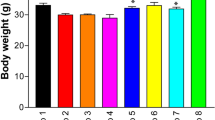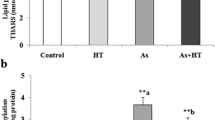Abstract
Arsenic toxicity becomes one of the major public health issues in several countries. Chronic and acute exposure to arsenic has been reported to be toxic to various systems of the human body and also observed in controlled experimental studies. The study was conducted to evaluate the neurotoxic effect of arsenic in Swiss albino mice and its amelioration by Vitamin E, Coenzyme Q10 and their combination. Swiss albino mice were treated with arsenic of 136 ppm for 15 days. The daily dose is 1/3 of LD 50 (acute) reported dose of arsenic. Thereafter, the animals were maintained either on drinking water or treated with Vitamin E (50 mg/kg bwt), Coenzyme Q10 (10 mg/kg bwt), and their combination by i.p.daily for 15 days. After the treatment, animals were sacrificed. The weight of the brain was marginally lower (ns), in arsenic-treated group as compared to control and antioxidant-protected groups. The LPO (lipid peroxidation) level was higher in arsenic-treated group, and this elevation was checked to some extent by the selected antioxidants which were statistically significant in combination of antioxidant-protected group. A significant reduction was found in GSH (reduced glutathione) level in the brain of arsenic-treated mice whereas GSH level was considerably higher in antioxidant-protected groups. Further, total thiol and total protein level were lower in arsenic-treated group. However, total thiol was significantly higher in antioxidant-protected groups. CAT (catalase) activity was significantly lower while SOD (superoxide dismutase) activity was marginally lowered in arsenic-treated group, and it was slightly higher in antioxidant-protected groups. Further, reduction in AChE (acetylcholinesterase) and BChE (butyrylcholinesterase) and motor coordination activity were also observed in arsenic-treated groups. Whereas, a higher AChE, BChE, and motor coordination activity was observed in antioxidant-protected group. These data indicate a positive role of selected antioxidant against the toxicity of arsenic in the brain of mice.
Similar content being viewed by others
References
Abdul KS, Jayasinghe SS, Chandana EP, Jayasumana C, De Silva PM (2015) Arsenic and human health effects: a review. Environ Toxicol Pharmacol 40(3):828–846
Acharyya N, Chattopadhyay S, Maiti S (2014) Chemoprevention against arsenic-induced mutagenic DNA breakage and apoptotic liver damage in rat via antioxidant and SOD1 upregulation by green tea (Camellia sinensis) which recovers broken DNA resulted from arsenic-H2O2 related in vitro oxidant stress. J Environ Sci Health C Environ Carcinog Ecotoxicol Rev 32:338–361
Adegboyega AM, Odunola OO (2012) The modulatory effects of aqueous extracts of Viscum album and garlic on sodium arsenite induced toxicity in Wistar albino rat. J Chem Pharm Res 4:4698–4701
Alizadeh-Ghodsi M, Zavvari A, Ebrahimi-Kalan A, Shiri-Shahsavar MR, Yousefi B (2018) The hypothetical roles of arsenic in multiple sclerosis by induction of inflammation and aggregation of tau protein: a commentary. Nutr Neurosci 21(2):92–96
Bhattacharya S (2017) Medicinal plants and natural products in amelioration of arsenic toxicity: a short review. Pharm Biol 55:349–354
Bhattacharya S, Haldar PK (2012) Trichosanthesdioica fruit ameliorates experimentally induced arsenic toxicity in male albino rats through the alleviation of oxidative stress. Biol Trace Elem Res 148:232–241
Bist R, Bhatt DK (2009) The evaluation of effect of alpha-lipoic acid and vitamin E on the lipid peroxidation, gamma-amino butyric acid and serotonin level in the brain of mice (Mus musculus) acutely intoxicated with lindane. J Neurol Sci 276:99–102
Biswas J, Roy S, Mukherjee S, Sinha D, Roy M (2010) Indian spice curcumin may be an effective strategy to combat the genotoxicity of arsenic in Swiss albino mice. Asian Pac J Cancer Prev 11:239–246
Buege JA, Aust SD (1978) Microsomal lipid peroxidation. Methods Enzymol 52:302–310
Claiborne A (1985) Catalase activity. In: Greenwald RA (ed) CRC handbook of methods in oxygen radical research. CRC Press, Boca Raton, pp 283–284
Ellman GL (1959) Tissue sulfhydryl groups. Arch Biochem Biophys 82(1):70–77
Ellman GL, Courtney KD, Andres V Jr, Featherstone RM (1961) A new and rapid colorimetric determination of acetylcholinesterase activity. Biochem Pharmacol l7:88–95
Flora SJS (2011) Arsenic-induced oxidative stress and its reversibility. Free Radic Biol Med 51(2):257–281
Flora SJS, Bhadauria S, Kannan GM, Singh N (2007) Arsenic induced oxidative stress and the role of antioxidant supplementation during chelation: a review. J Environ Biol 28(2):333
Fouad AA, Al-Sultan AI, Yacoubi MT (2011) Coenzyme Q10 counteracts testicular injury induced by sodium arsenite in rats. Eur J Pharmacol 655(1):91–98
Giasson BI, Sampathu DM, Wilson CA, Vogelsberg-Ragaglia V, Mushynski WE, Lee VMY (2002) The environmental toxin arsenite induces tau hyperphosphorylation. Biochemistry 41(51):15376–15387
Greig NH, Utsuki T, Ingram DK, Wang Y, Pepeu G, Scali C, Chen D (2005) Selective butyrylcholinesterase inhibition elevates brain acetylcholine, augments learning and lowers Alzheimer β-amyloid peptide in rodent. Proc Natl Acad Sci U S A 102(47):17213–17218
Gupta R, Flora SJ (2006) Effect of Centellaasiatica on arsenic induced oxidative stress and metal distribution in rats. J Appil Toxicol 26(3):213–222
Habig WH, Pabst MJ, Jakoby WB (1974) Glutathione S-transferases the first enzymatic step in mercapturic acid formation. J Biol Chem 249(22):7130–7139
Herrera A, Pineda J, Antonio MT (2013) Toxic effects of perinatal arsenic exposure on the brain of developing rats and the beneficial role of natural antioxidants. Environ Toxicol Pharmacol 36(1):73–79
Hu ML (1994) Measurement of protein thiol groups and glutathione in plasma. Methods Enzymol 233:380–385
Jain A, Yadav A, Bozhkov AI, Padalko VI, Flora SJ (2011) Therapeutic efficacy of silymarin and naringenin in reducing arsenic-induced hepatic damage in young rats. Ecotoxicol Environ Saf 74(4):607–614
John S, Kale M, Rathore N, Bhatnagar D (2001) Protective effect of vitamin E in dimethoate and malathion induced oxidative stress in rat erythrocytes. J Nutr Biochem 12(9):500–504
Jomova K, Jenisova Z, Feszterova M, Baros S, Liska J, Hudecova D, Rhodes CJ, Valko M (2011) Arsenic: toxicity, oxidative stress and human disease. J Appl Toxicol 31(2):95–107
Kumar V, Prakash C (2015) Arsenic induced oxidative stress and mitochondrial dysfunction in rat brain. SpringerPlus 4(1):P20
Lawley SD, Yun J, Gamble MV, Hall MN, Reed MC, Nijhout HF (2014) Mathematical modeling of the effects of glutathione on arsenic methylation. Theor Biol Med Model 11(1):20
Levine RL, Berlett BS, Moskovitz J, Mosoni L, Stadtman ER (1999) Methionine residues may protect proteins from critical oxidative damage. Mech Ageing Dev 107(3):323–332
Lowry OH, Rosebrough NJ, Farr AL, Randall RJ (1951) The original method for protein estimation. Biol Chem 193:265
Marklund S, Marklund G (1974) Involvement of the superoxide anion radical in the autoxidation of pyrogallol and a convenient assay for superoxide dismutase. FEBS J 47(3):469–474
Mishra D, Flora SJ (2008) Differential oxidative stress and DNA damage in rat brain regions and blood following chronic arsenic exposure. Toxicol Ind Health 24(4):247–256
Muthumani M, Miltonprabu S (2015) Ameliorative efficacy of tetrahydrocurcumin against arsenic induced oxidative damage, dyslipidemia and hepatic mitochondrial toxicity in rats. Chem Biol Interact 235:95–105
Muthumani M, Prabu SM (2012) Silibinin potentially protects arsenic-induced oxidative hepatic dysfunction in rats. Toxicol Mech Methods 22(4):277–288
Nagaraja TN, Desiraju T (1994) Effects on operant learning and brain acetylcholine esterase activity in rats following chronic inorganic arsenic intake. Hum Exp Toxicol 13(5):353–356
Nirankari S, Kamal R, Dhawan DK (2016) Neuroprotective role of quercetin against arsenic induced oxidative stress in rat brain. J Environ Anal Toxicol 6:359
Ognjanović BI, Marković SD, Ðorđević NZ, Trbojević IS, Štajn AŠ, Saičić ZS (2010) Cadmium-induced lipid peroxidation and changes in antioxidant defense system in the rat testes: protective role of Coenzyme Q10 and Vitamin E. Reprod Toxicol 29(2):191–197
Pace C, Dagda R, Angermann J (2017) Antioxidants protect against arsenic induced mitochondrial cardio-toxicity. Toxics 5(5, 4)
Parvez F, Wasserman GA, Factor-Litvak P, Liu X, Slavkovich V, Siddique AB, Sultana R, Sultana R, Islam T, Levy D, Mey JL, van Geen A, Khan K, Kline J, Ahsan H, Graziano JH (2011) Arsenic exposure and motor function among children in Bangladesh. Environ Health Perspect 119(11):1665–1670
Pascoe G, Olafs dottier F, Read D (1987) Vitamin E protection against chemical induced cell injury. Maintenance of cellular protein thiols as a cytoprotective mechanism. Arch Biochem Biophys 256:150–158
Patel B, Das R, Gautam A, Tiwari M, Acharya S, Kumar S (2017) Evaluation of vascular effect of arsenic using in vivo assays. Environ Sci Pollut Res 24(18):15521–15527
Patlolla AK, Tchounwou PB (2005) Serum acetyl cholinesterase as a biomarker of arsenic induced neurotoxicity in Sprague-dawley rats. Int J Environ Res Public Health 2(1):80–83
Rahangadale S, Kurkure N, Prajapati B, Hedaoo V, Bhandarkar AG (2012) Neuroprotective effect of Vitamin E supplementation in wistar rat treated with acrylamide. Toxicol Int 19(1):1–8
Ravenscroft P, Brammer H, Richard K (2009) Arsenic pollution: a global synthesis. Wiley-. Blackwell, Hoboken Published Online: 30
Rodriguez VM, Carrizales L, Jimenez-Capdeville ME, Dufour L, Giordano M (2001) The effects of sodium arsenite exposure on behavioral parameters in the rat. Brain Res Bull 55:301–308
Rodriguez VM, Jimenez-Capdeville ME, Giordano M (2003) The effects of arsenic exposure on the nervous system. Toxicol Lett 145(1):1–18
Rodriguez EG, Bellinger DC, Valeri L, Hasan MO, Quamruzzaman Q, Golam M, Kile ML, Christiani DC, Wright RO, Mazumdar M (2016) Neurodevelopmental outcomes among 2- to 3-year-old children in Bangladesh with elevated blood lead and exposure to arsenic and manganese in drinking water. Environ Health 15:44
Scott N, Hatlelid KM, MacKenzie NE, Carter DE (1993) Reactions of arsenic (III) and arsenic (V) species with glutathione. Chem Res Toxicol 6(1):102–106
Sharma A, Bist R (2014) Thiamine deprivation disturbs cholinergic system and oxidative stress in liver of Mus musculus. Int J Pharm Pharm Sci 6:139–143
Sharma A, Bist R, Bubber P (2013) Thiamine deficiency induces oxidative stress in brain mitochondria of Mus musculus. J Physiol Biochem 69(3):539–546
Silver A (1974) The Biology of Cholinesterases. ElsevierAgricultural Research Council Institute, New York, pp 426–447
Sińczuk-Walczak H (2009) Nervous system disorders induced by occupational exposure to arsenic and its inorganic compounds: a literature review. Med Pr 60(6):519–522 (In polish)
Smith AH, Lingas EO, Rahman M (2000) Contamination of drinking-water by arsenic in Bangladesh: a public health emergency. Bull World Health Organ 78(9):1093–1103
Somayajulu M, McCarthy S, Hung M, Sikorska M, Borowy-Borowski H, Pandey S (2005) Role of mitochondria inneuronal cell death induced by oxidative stress; neuroprotection by Coenzyme Q10. Neurobiol Dis 18(3):618–627
Tolins M, Ruchirawat M, Landrigan P (2014) The developmental neurotoxicity of arsenic: cognitive and behavioral consequences of early life exposure. Ann Glob Health 80:303–314
Tyler CR, Allan AM (2014) The effects of arsenic exposure on neurological and cognitive dysfunction in human and rodent studies: a review. Curr Environ Health Rep 1(2):132–147
Yadav RS, Sankhwar ML, Shukla RK, Chandra R, Pant AB, Islam F, Khanna VK (2009) Attenuation of arsenic neurotoxicity by curcumin in rats. Toxicol Appl Pharmacol 240(3):367–376
Acknowledgments
The authors are thankful to ICMR for awarding the Post Doctoral fellowship to one of us (AS) is thankfully acknowledged. Authors are thankful to Dr. Satish Patel, Zydus Research Centre, Ahmedabad for providing the animals for the study. Authors are also thankful to Dr. DN Gandhi, Former, Scientist E, NIOH for his assistance in motor coordination study and staff of animal house facility of NIOH especially Dr. Rajendra Palkhade are also acknowledged for their cooperation.
Author information
Authors and Affiliations
Corresponding author
Additional information
Responsible editor: Philippe Garrigues
Rights and permissions
About this article
Cite this article
Sharma, A., Kshetrimayum, C., Sadhu, H.G. et al. Arsenic-induced oxidative stress, cholinesterase activity in the brain of Swiss albino mice, and its amelioration by antioxidants Vitamin E and Coenzyme Q10. Environ Sci Pollut Res 25, 23946–23953 (2018). https://doi.org/10.1007/s11356-018-2398-z
Received:
Accepted:
Published:
Issue Date:
DOI: https://doi.org/10.1007/s11356-018-2398-z




